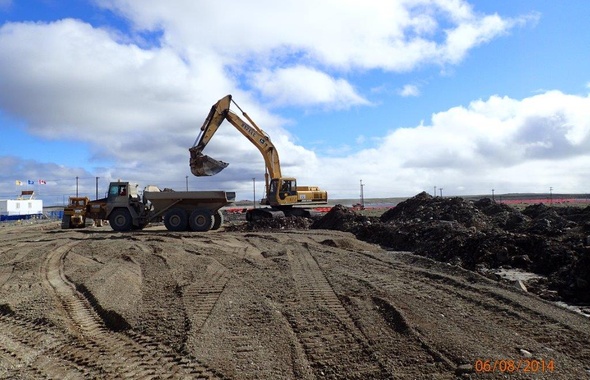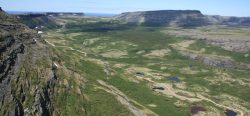Contact Details
STATION NAME AND OWNER
The Canadian High ArcticDefinitions of the Arctic vary according to environmental, geographical, political, cultural and scientific perspectives. Some scientists define the Arctic as areas having a high latitude, long winters, short, cool summers,... More Research Station (CHARS) campus is owned by the Government of Canada and Managed by Polar Knowledge Canada (POLAR).
LOCATION
The Canadian High ArcticDefinitions of the Arctic vary according to environmental, geographical, political, cultural and scientific perspectives. Some scientists define the Arctic as areas having a high latitude, long winters, short, cool summers,... More Research Station (CHARS) campus is located in Cambridge Bay, Nunavut. The Kitikmeot hamlet’s central northern location provides good access to all parts of the Canadian ArcticDefinitions of the Arctic vary according to environmental, geographical, political, cultural and scientific perspectives. Some scientists define the Arctic as areas having a high latitude, long winters, short, cool summers,... More. The CHARS campus is located on the Plateau site in Cambridge Bay, on a slope overlooking the community and the bay. The site is close to other major infrastructure, including the community core.
BIODIVERSITY AND NATURAL ENVIRONMENT
The climate in the Cambridge Bay area is characterized by a high degree of continentality, demonstrated by a large mean annual temperature range of ~45°C, and some of the lowest annual precipitation amounts (100–150 mm) experienced in the Canadian ArcticDefinitions of the Arctic vary according to environmental, geographical, political, cultural and scientific perspectives. Some scientists define the Arctic as areas having a high latitude, long winters, short, cool summers,... More Islands. The annual mean temperature in Cambridge Bay increased by 1.1°C between 1961 and 2010, with most of the warming occurring during the winter months. The bedrock in the southeastern Victoria Island region around Cambridge Bay is Cambrian limestone, and a wide range of periglacial landforms occur, e.g. patterned ground, solifluction lobes, and thermokarst lakes. Permafrost is continuous, with active layers during summer ranging from 30 cm under wetlands to about 1.5 m under upland sites. In terms of bioclimatic zones, the region is in CAVM Subzone D, characterized by dwarf shrub tundra, with a vascular flora of c. 150 plant species. The arthropod fauna around Cambridge Bay is relatively diverse and consists of hundreds of insect and spider species. Cambridge Bay is an important fishing area for arcticDefinitions of the Arctic vary according to environmental, geographical, political, cultural and scientific perspectives. Some scientists define the Arctic as areas having a high latitude, long winters, short, cool summers,... More char and lake trout, and has a small commercial char fishery. Southern Victoria Island is an important staging and nesting area for many migratory birds, particularly waders (shorebirds). It also has sizeable populations of caribou, muskox, arcticDefinitions of the Arctic vary according to environmental, geographical, political, cultural and scientific perspectives. Some scientists define the Arctic as areas having a high latitude, long winters, short, cool summers,... More hare, arcticDefinitions of the Arctic vary according to environmental, geographical, political, cultural and scientific perspectives. Some scientists define the Arctic as areas having a high latitude, long winters, short, cool summers,... More fox, and arcticDefinitions of the Arctic vary according to environmental, geographical, political, cultural and scientific perspectives. Some scientists define the Arctic as areas having a high latitude, long winters, short, cool summers,... More wolf.
HISTORY AND FACILITIES
The CHARS campus was first announced in 2007. Construction of the infrastructure began in 2014. It is a world-class hub for science and technology in Canada’s North that connects a network of regional facilities. The Station will provide a suite of services for Science and Technology (S&T) and IndigenousBelonging to a certain place. Indigenous people are distinct ethnic groups that have historic connections to people who lived in a territory prior to the area being colonized or coming... More knowledge in Canada’s North, including a knowledge sharing center, and advanced laboratories. Polar Knowledge Canada (POLAR) operates the CHARS campus.
GENERAL RESEARCH AND DATABASES
Polar Knowledge Canada recognizes the critical importance of broad-based input, especially from Northerners, in the development and implementation of its Science and Technology Programs. Its Science and Technology Plan for 2015-2020 outlines the following priorities: (i) Alternative and renewable energy for the North; (ii) Baseline information to prepare for northern sustainability; (iii) Predicting the impacts of changing ice, permafrostPermafrost is frozen ground that remains at or below zero degrees Celsius (32 degrees Fahrenheit) for two or more years. It forms in regions where the mean annual temperature is... More, and snow on shipping, infrastructure and communities; (iv) Catalysing improved design, construction, and maintenance of northern built infrastructure. POLAR recently collected input to inform its next 5-year Research Plan and broader agency-wide Strategic Plan, to guide future programs and activities over a 5-year period beginning in 2020.
HUMAN DIMENSION
Cambridge Bay (Iqaluktuttiaq in Inuinnaqtun, meaning “good fishing place”) is a hamlet located on Victoria Island in the Kitikmeot Region of Nunavut, Canada. The hamlet has a population of c. 1600 people of which about 80% are Inuit. The community is the largest stop for passenger and research vessels traversing the ArcticDefinitions of the Arctic vary according to environmental, geographical, political, cultural and scientific perspectives. Some scientists define the Arctic as areas having a high latitude, long winters, short, cool summers,... More Ocean’s Northwest Passage. Situated between Dease Strait and Queen Maud Gulf on the southeast coast of Victoria Island, part of the Canadian ArcticDefinitions of the Arctic vary according to environmental, geographical, political, cultural and scientific perspectives. Some scientists define the Arctic as areas having a high latitude, long winters, short, cool summers,... More Archipelago, Cambridge Bay is a transportation and administrative centre for the Kitikmeot Region. The area was a traditional hunting and fishing location and archaeological sites are often found. Barren-ground caribou, muskox, arcticDefinitions of the Arctic vary according to environmental, geographical, political, cultural and scientific perspectives. Some scientists define the Arctic as areas having a high latitude, long winters, short, cool summers,... More char, lake trout, and ringed seal were and remain important primary food sources.
ACCESS
The only passenger services are through the Cambridge Bay Airport with daily air service to Yellowknife, and to the other Kitikmeot Region communities. Although Cambridge Bay lies on the Northwest Passage there are no passenger ships other than tourist cruises and annual sealift to the community. Charter and MEDIVAC (air ambulance) services are available.
Note: Information in the Field Site Information Table is out of date. For current information, please contact Polar Knowledge Canada at info@polar.gc.ca






















